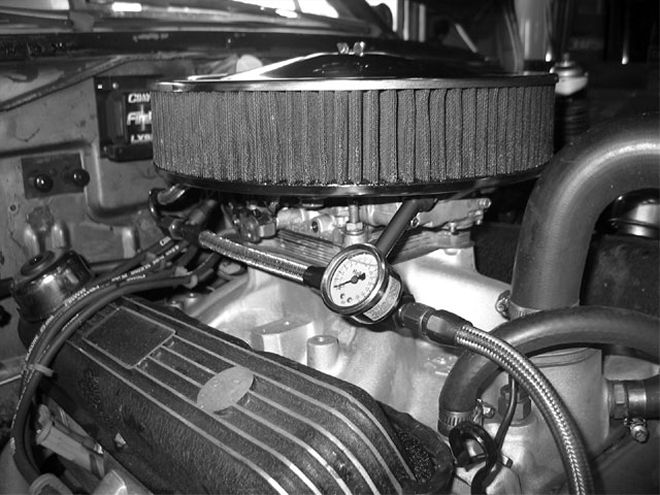

It all started because I was having a fuel problem. After driving the Valiant for any extended period of time, it would act like it was running out of fuel. When I was finally able to get the time to look at it, I found that the stock mechanical fuel pump was heat sinking (absorbing the heat from the engine), and vaporlocking.
There are a couple of different ways to remedy this situation. One would be to plumb a return line from the pump to the fuel tank, giving the pump a constant flow of circulated fuel. Since the fuel would be in continuous cycles from the tank to the pump and back to the tank, it would effectively help keep the fuel pump cooler. Another idea is to remove the pump from the engine. To do this requires installing an electric pump in the system.
An electric pump is designed to be more efficient if it is installed in a location as close to the tank as possible. The reason for this is to "push" the fuel to the carburetor, as opposed to being mounted near the engine and "pulling" the fuel from the tank. Knowing that the Valiant will be receiving a different engine in the future with a larger appetite for fuel, we decided to do more than simply install a pump near the tank and call it quits.
The fuel tank in the Valiant has been in the car since it was built. As such, it's hard to say what kind of debris and gunk has attached itself to the metal inside. Sure, there are ways to clean a fuel tank, but when we noticed a leak, we knew the time for a new one was upon us. The problem with simply replacing the old tank with a new one is the original feed line out of the tank is only 5/16 inch. Feeding any kind of high-horsepower engine with that size line is asking for trouble. Another downfall is the fuel is sucked from the front of the tank. Fuel starvation during hard acceleration is an issue we wanted to avoid. To best solve the issue presented by a stock fuel system, we ordered a new fuel tank from Year One and a universal fuel-tank sump kit from Competition Engineering. The task of installing a rear fuel sump to any fuel tank requires welding and modification. If you are not comfortable with welding to your fuel tank, seek professional help. For those of you that do feel comfortable, please make sure to take the appropriate measures so there is no explosion while welding if you are using the old tank.
Having a modified fuel tank is only half of the equation. You need to get the fuel from the tank to the engine. Several companies make aftermarket fuel pumps, and deciding which one is right for your application requires you to plan what the demands on your fuel system are. We were not in need of a full-boogie, Pro-Stock-style fuel system, so we ordered a Holley "Blue" fuel pump. The Holley pump comes with the required fuel regulator, and will sufficiently feed a strong running street mill. The Blue pump will free-flow 110 gallons of fuel per hour at 14 psi. Since the 14-psi rating will overpower the needle and seat assembly in the carburetor, Holley also supplies the needed fuel regulator with the pump. We could have simply bent up some steel line and rubber hose for the connections, but we wanted the finished system to look like we knew what we were doing. Earl's, a division of Holley, has just about every fitting and hose you would need to install a complete fuel system in your Mopar, and we decided to give them a try. Before you order parts for your fuel system, it is a smart idea to draw a picture of the system you plan to build and write down the part number of every fitting you will need. Simply trying to play it by ear and hope for the best will result in a lot of phone calls to get more fittings and down time for your car. Now that we gave you our rendition of why and who, let's get to the meat and potatoes of doing it.